Earthquakes, for most of us, are not a common natural phenomenon. However, it’s surprising to note that in the US, all 50 states are considered to be at moderate risk for some sort seismic activity. Even if you don’t live one of the notorious seismic hotbeds of activity, it’s important to at least have some knowledge of how to prepare for these types of disasters, and the kind of damage they can cause.
[the_ad_placement id=”in-text-1-type-r”]For those of us in the preparedness mindset, an earthquake is the ultimate reminder of that old cardinal rule, that we can’t always count on municipal or regional weather services to warn us of an impending disaster. As it stands now, even with all of the geological observation and technology we have today, there is no way for us to predict the eventuality or timing of an earthquake.
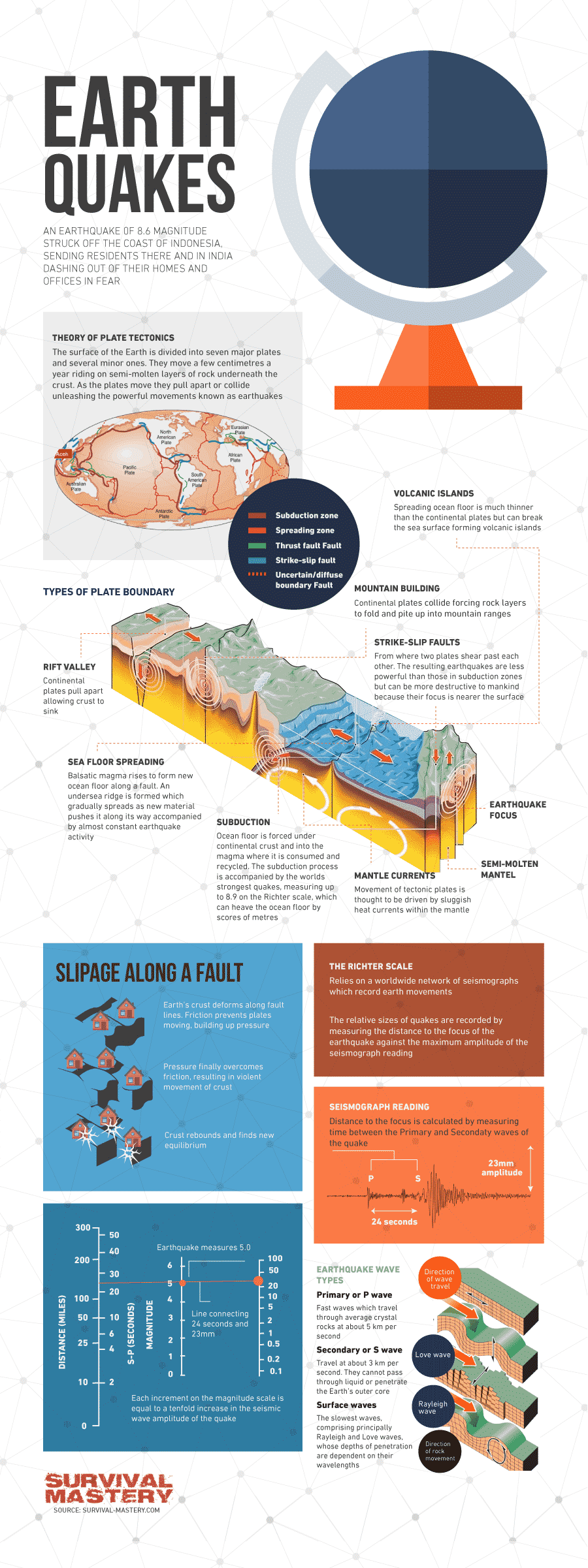
Geologists are able to track the progress of these natural phenomenon, measure their strength, and often times pinpoint their origin of the seismic disturbance. This has led as least to some earthquake warning systems in places like California, that utilize geologic measurements to sound alarms when a quake is in progress. Even so, Japan remains the only country in the world with a comprehensive nation-wide earthquake warning system.
The bottom line here is that you can’t really count on any kind of heads up when an earthquake is coming. There is no time to prepare, there is no time to Google what to do-you just have to know. Here we’ll go through some of the staples of a common earthquake preparedness kit, as well as some precautionary measures that you can take around your home.
Beginning with the basics
To prepare for an earthquake, you really just need to prepare like you would for any other disaster. Earthquakes, in their destructive nature, tend to take out a lot of the same basic systems that things like tornadoes and blizzards do. For a better understanding of natural disasters occurring in any location, their features and measures you need to take, read our article on how to prepare for a natural disaster.
How this can affect you and your household largely depends on the setting you live in. Those who live in suburban areas and are more heavily dependent on municipal systems for utilities may find greater difficulty in establishing independent systems, but faster response time for community clean up and emergency relief.
People living in rural settings typically see the adverse-a more independent lifestyle makes it easier for them to adapt to an emergency, but they tend to see longer wait times for things like clearing roads, awaiting emergency medical treatment, and repair of utilities.
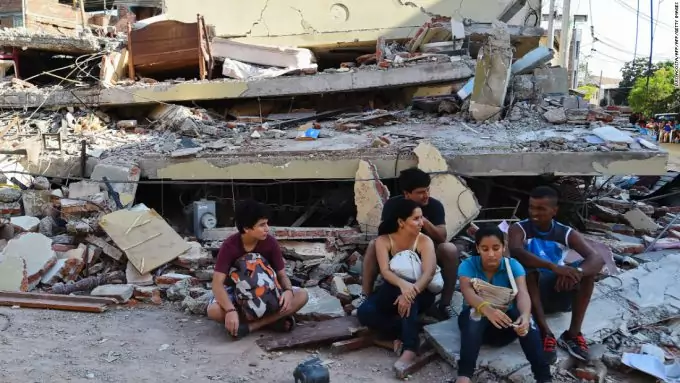
Evaluate your setting, and determine where the strengths and weakness lie in your location. How long will you be without power? How far of a drive is it to get supplies and gas, and is it passable by foot or bike if need be? Asking yourself these questions now will help to prepare you for how long of a haul you could in for should an earthquake take out several of your basic systems, like the ones listed below.
How much food you need to prepare?
Like with many other forms of natural disaster, roads can be damaged, making trips to the grocery store impossible. This is where your food preps come in. Though most government-run disaster relief organizations say only a few days of non-perishable food is needed, I feel like that’s a lot of wishful thinking. If there is severe enough damage to public roadways in that travel by motorized vehicle is impossible, it could take much longer than a few days to get those repairs in order. Also, check out our list of long shelf life food to guide you on your preparation.
And if you live in a rural area, you may see an even longer wait, plus a longer commute to purchase supplies. If you can’t just walk three blocks to the nearest convenience store, you’re going to be in a bit of a bind as you wait for road work to wrap up.
I think it’s much better to have at least 3 weeks of non-perishable food on hand, at all times, for whatever disaster may strike (even if it’s just a shoddy month for work and you can’t afford groceries). And of course, make absolutely certain you have at least one good manual can opener with those food preps, so you’re not banging on them with a hammer and a flathead, trying to get a can of soup open.
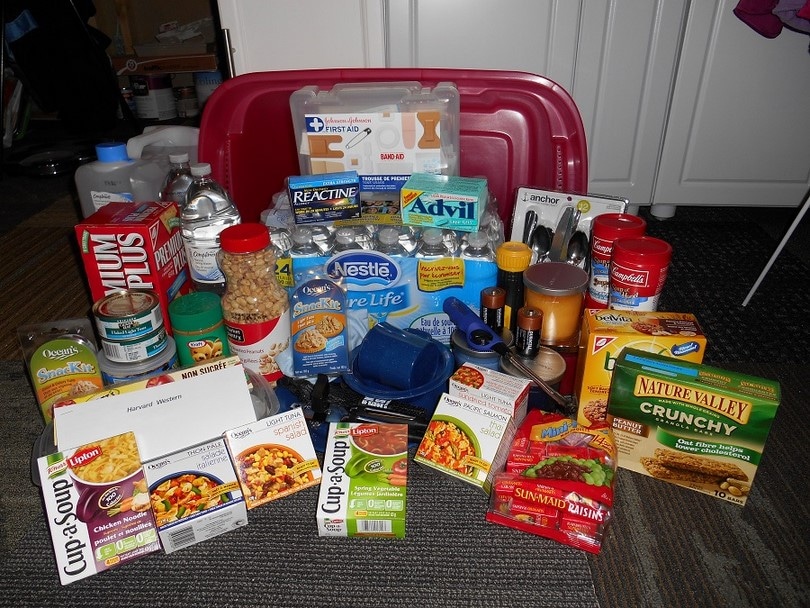
Store simple things that you can make multiple meals with, like rice, beans, freeze dried or canned meats and vegetables, etc. Many people even go so far as to put together their own MRE’s, pre-seasoned and ready to go, so all you usually need to do it put them in some boiling water. If you want to be one step ahead and have a plan ready for disaster occurrence, you can find more information about survival emergency food kits in this article.
Water is very important
That being said, many people don’t realize that their water systems are largely dependent on electricity to run. Municipal water facilities could just as easily lose power, especially in such a cataclysmic event like an earthquake, so that city dwellers may see their water pressure vanish and their sanitation systems become useless.
Even those on independent well water have electric pumps that bring their water to the surface, and a pressure tank (unless you’re one of the lucky ones that is able to gravity-pressurize your water supply) to push it through their pipes and fixtures.
Water is hugely important, so stockpile it now, before you need it. Designate a cool, dark area, acquire some containers (plenty of options there, depending on how thrifty or ‘’spendy’’ you want to be), and stock plenty of clean, filtered water. Factor in how much you’ll need for a few weeks, including not just cooking and drinking, but sanitation (brushing your teeth, bathing), watering pets or livestock, etc.
You may find the needs a bit exorbitant, and pressing of the space you have to store it, but stock as much as you can, and then have a back-up plan for obtaining more clean water should those reserves run out. A good option is to know how to purify water, and for that, we covered the in-depth procedure in this great article on how to make a water filter.
First aid and medications
In addition to these basics, you’ll want a basic first aid kit on hand, and a field medicine guide never hurt, either. There are some truly excellent resources for those that may have the unfortunate experience of having to practice medicine with absolutely no clue what they’re doing.
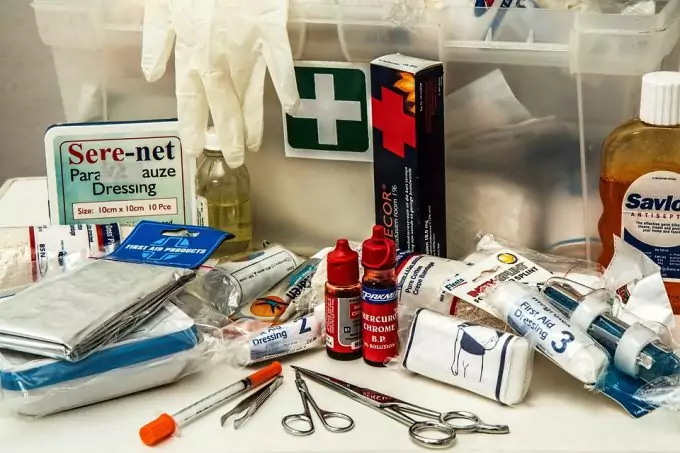
Mainly, acquire plenty of sterile gauze, sponges, bandages, and basic medicines, like anti-inflammatories, pain relievers, and if you can, antibiotics. These staples may pale in comparison with professional medical treatment, but in a scenario where you may not have access to a hospital or an ambulance may not be able to make it down your crumbled road, they can certainly help. Further more, a good idea would be to have a first aid kit in your house, like a 326-piece one, easy to use in any situation. This choice and many more are covered in our article about the best first aid kits which you can find here.
Energy sources
A power source is a good idea for any emergency kit, to fuel everything from emergency lighting to cooking aids. Consider the types of power available to you, and stock your kit with devices compatible with that source. For example, if you have a wood stove or a fireplace, this is a great place to get your cooking done. Have plenty of firewood on hand, in all seasons, and of course a large supply of matches.
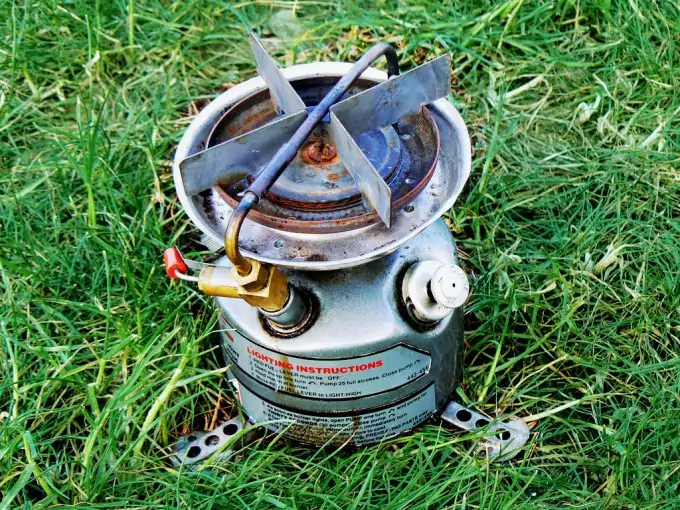
Consider your light sources carefully, and how much you’ll be using them. Is a pack of AA batteries going to get you through what could turn out to be weeks without power? Consider alternatives to what you may be used to, like portable solar panels, and homemade power set ups, like battery banks. In any case, surviving without electricity is hard, but not impossible and you can take a look at our article on surviving without electricity to know what your options are.
With food, water, first aid, and power covered, you’re well on your way to putting together one hell of an earthquake preparedness kit. How deep into it you want to go really depends on you, and how much money, space, and resources you have to put into it, as well as the likeliness that an earthquake will strike your area.
Getting seismic: special additions for earthquakes
With a unique geological event like an earthquake comes some unique needs when you’re putting together your preparedness kit. Walls shake, foundations crumble, furniture crashes to the floor-they create one hell of a dangerous mess. With this in mind, there are some special considerations to protect both yourself and your belongings that you’ll want to add to your earthquake preparedness kit.
Secure everything
This is actually one of those rare preemptive measures that you can take to safe guard some of your possessions before the tremors start. Go around your house, and look at everything on the walls.
[the_ad_placement id=”in-text-2-type-r”]Even when you’re not prepping for an earthquake, it’s always a good idea to mount things to studs. These are the beams of wood underneath your sheetrock or drywall, and often are tied directly into your house’s foundation. This makes them incredibly sturdy-unless your foundation is compromised (not altogether impossible in an earthquake), then these aren’t likely to go anywhere.
Consider hanging pictures and art with wire and secure stud mounted screws, instead of flimsy brackets in drywall. The vibrations from the quake will run through the brittle flimsy connection, and buck them right off the wall. However, the stability of the stud will hold the frame in place, while the wire will allow them to swing freely.
Heavy furniture is of particular concern, so take thorough measures to mount these to studs as well, using nylon straps anchored to screws to distribute motion. Things like bookcases and china cabinets can become deadly in the face of a quake, falling and crushing people under their immense size and weight.
Particularly expensive items should be on your list of things to secure as well. Make sure that your flat screen TV is mounted to the wall in such a way that it allows for distribution of motion. And of course, always mount to a stud. Have additional strap and tethers in your kit to secure items as the earthquake becomes evident (if there’s time). You may not always want things like computers and kitchen appliances strapped down, but it’s nice to have the option once things get moving.
Have a safe place to go
It’s hard to imagine a safe place to be as your whole house rumbles in the throes of an earthquake. However, there are a few places in a conventional home that are safer to be than others when you start feeling the earth move under your feet.
Over the years there, false information has abounded as to the safest place to be in your home during a quake, much of it even suggesting that you run outside to avoid being crushed by a collapsing structure.
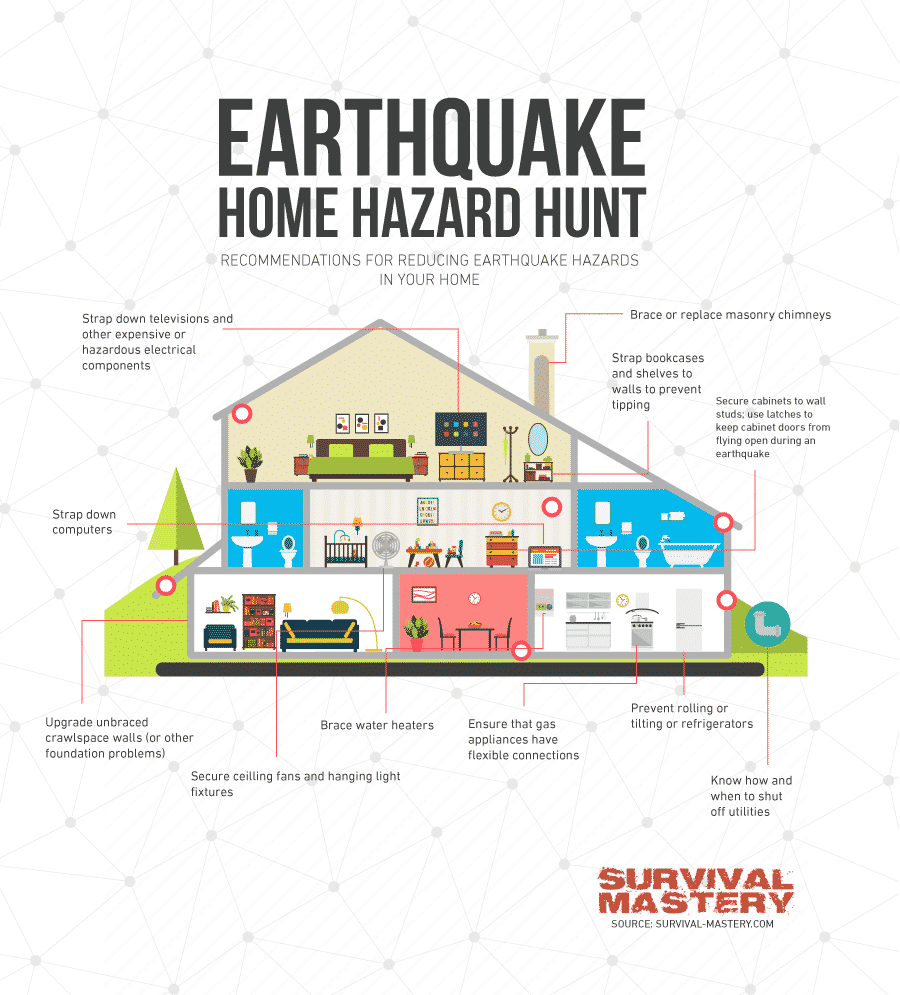
However, statistical data has proven time and time again that the safest thing to do during a quake is to stay put as much as possible. As those tectonic plates begin to violently shift, they can cause the ground you’re standing on to move back and forth a couple of feet per second. The chances of you being able to stand-let alone run or walk-in these conditions, is very slim. You’re more likely to seriously injure yourself with a twisted ankle or worse, and be immobilized than you are to make it to a different location.
The best thing to do? Rejoice in the craftsmanship of heavy Amish furniture. No, really. Time and time again, researchers have found that the old adage of drop, cover, and hold on, really does save lives. Though most buildings that follow today’s rigorous engineering codes aren’t likely to collapse, if they do, a sturdy table is your best bet for protecting from falling objects and debris. Countless images circulate on the Internet of heart-breaking scenes of building rubble, and in the midst of that carnage, a lone table, still standing.
So even if the worst should happen, and your building collapses, a sturdy table is likely to save your life.
Dropping to your knees as soon as the shaking begins will get you into a safer position, so you aren’t thrown off your feet, and leave you still mobile to seek shelter. As part of your earthquake prepping, consider anchoring your go-to sturdy table to the floor, or even affixing handles underneath it, to give you something sturdy to hold onto.
Communications
In the aftermath of any disaster, it’s entirely possible that telephone lines or cell phone towers can be damaged. This coupled with power outages (remember, you can’t use a modern cordless landline without power, or charge your cell phone) could render you without a means to communicate for an unknown amount of time. If you live in a rural area, it could be a considerable amount of time before you receive assistance, and without a phone, you lack the means to call in emergency assistance. Check out our piece on how to choose the best all-weather radio for more information.
[the_ad_placement id=”in-text-3-type-r”]So with your earthquake preparedness kit, make sure you have at least some means of independent communication, and that you know how to use it. Two-way radios are typically the best way to go, though they can be expensive. Even so, when your life is on the line, the price should not matter. We have a detailed review on the best two way radios for all pockets that you can read here. The important thing if you buy a set of these though is to be aware of the channels your local emergency response teams use, and how to reach them. And it goes without saying to make sure that you have these always powered up and at the ready, with a backup auxiliary power source, should the electrical grid fail.
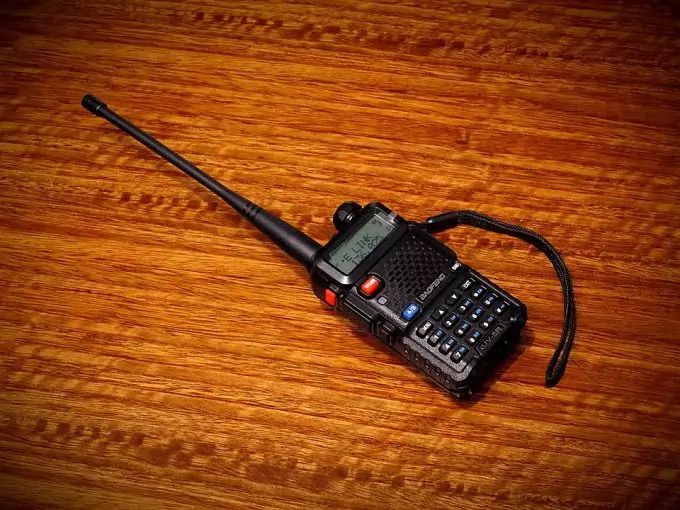
In addition to communication electronics, there’s one facet of this category that often gets overlooked, and that’s communicating these plans with your family. All of the planning in the world won’t do you a bit of good if you’re the only one aware of what to do when an emergency arises.
Sit down with your entire household, and go over every part of your emergency kit, as well as your back up power system and communication devices, and make sure that everyone knows not only where everything is, but how it all works. It’s helpful to write up plans and instructions, laminate them, and stick them inside the kit as well, for reference. Again, it’s kind of a no-brainier, but many great plans fail because of poor communicators.
Hoping for the best, and planning for the worst
If you don’t live in a tectonic hot zone, this information may feel as if it’s of little consequence to you. But keep in mind that earthquakes strike at the most unpredictable and unexpected of times; this isn’t fear-mongering, it’s fact. They can be separated by as little as a few hours or as much as a thousand years. Their precursors are highly complex, they are impossible to predict, and the damage they can cause is devastating.
There’s a wonderful saying that may come across as a little cynical, even a little stereotypical prepped of me, but it’s one of my favorites: Hope for the best, plan for the worst. Even if you never see an earthquake in your lifetime, where’s the drawback really in compiling this simple kit? It’s a very basic emergency kit, with a few items thrown in to make your belongings sturdier and safer (something parents of toddlers often do already). You have little to lose by following these simple steps, and should an earthquake actually strike, you’ll have everything to gain.
Be prepared and ready. For more information on how to survive an earthquake, see our article on this important topic.


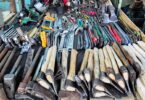
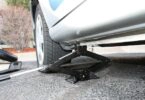


I think the most important thing when disaster come knocking on the door is to have access to clean water, period. That’s why I’ve water to last me for months to come. I also have flashlights, radio, batteries, and of course lots of food.
You should make a plan for different and difficult scenarios that might happen. Of course, as soon as you have your supplies/stocks don’t leave your loved ones behind, expectedly electricity/phone lines will be unavailable, so beforehand, have a designated meeting spot. and yes! clean water
Earthquakes are an interesting topic to think about. In such a chaotic situation it is not easy to figure out some things that must be done. Every earthquake seems different from the other. I make sure to always have a secure room filled with plenty of food and water, and to always have an emergency backpack on standby.
Thank you Jayne for sharing your opinion with us.